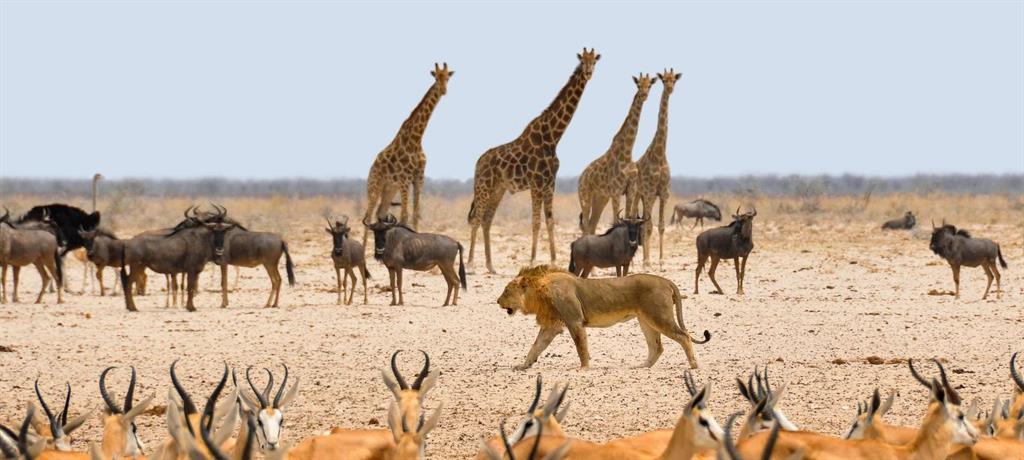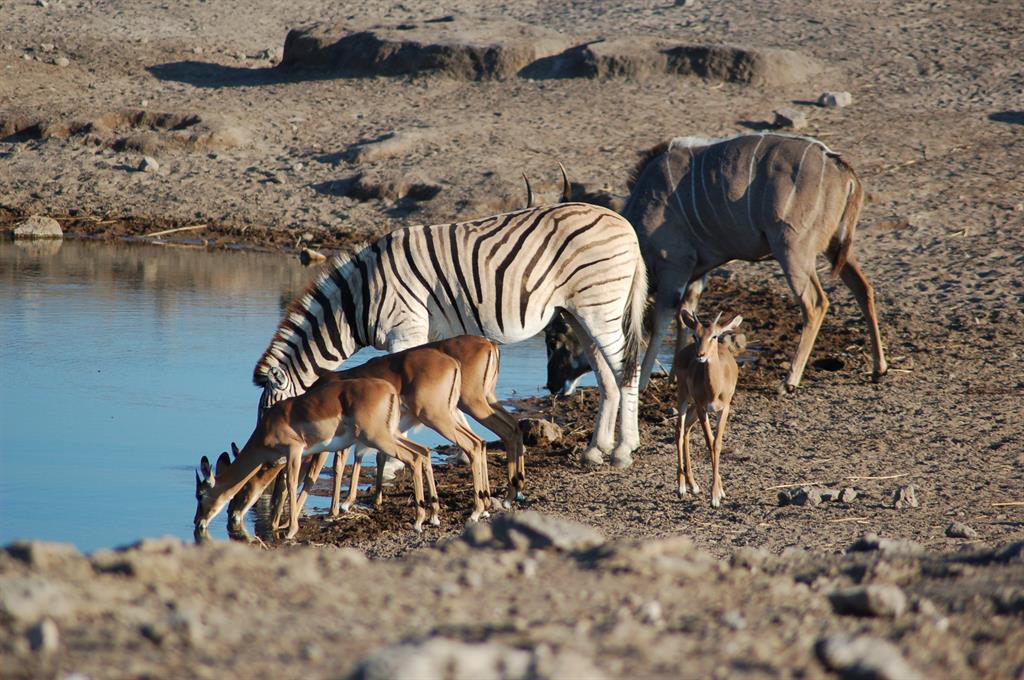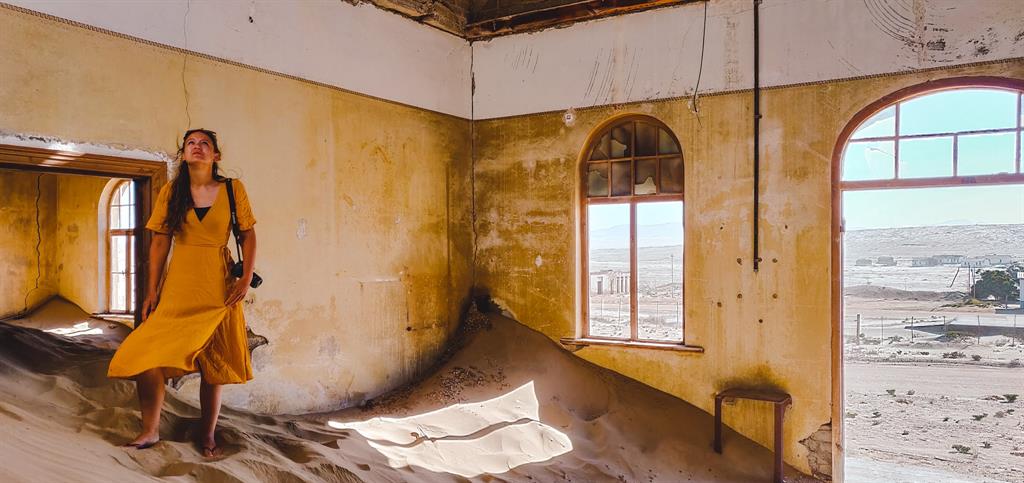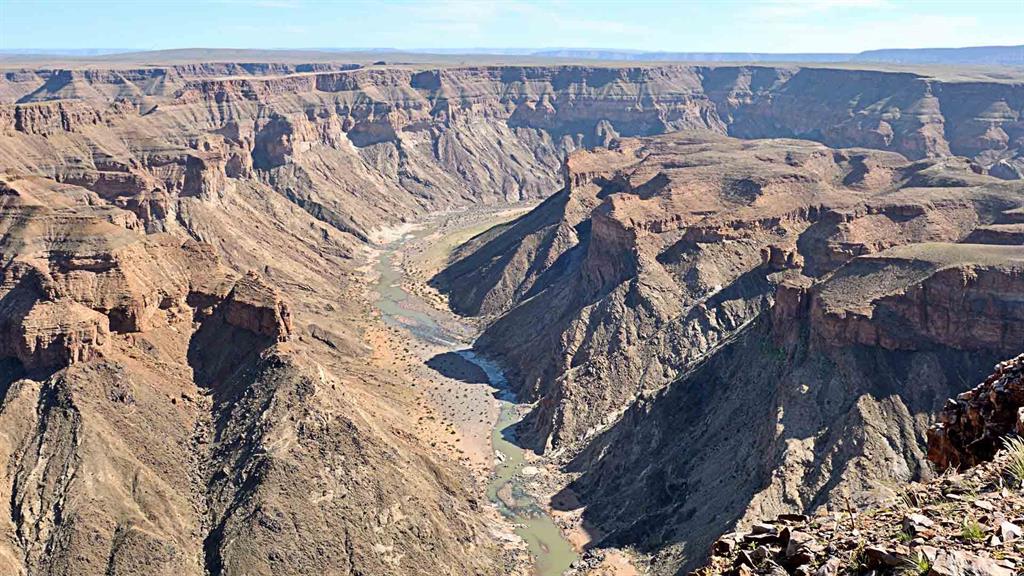Top ten places to visit in Namibia.
It is a top destination for those who enjoy nature, grandiose landscapes, spectacular sand dunes and first-class wildlife viewing.
Staff Reporter
Namibia, a country in the southwestern region of Africa, is distinguished by the Namib Desert – the oldest desert of the world – along its Atlantic Ocean coast. The country is home to diverse wildlife, including the big five and also a significant cheetah population. As do most of the towns, the capital, Windhoek, and coastal town Swakopmund have maintained many buildings dating back to the German colonial era – one of the better-known buildings is the Christus Kirche of Windhoek, built in 1907. In the north, the Etosha National Park does not only comprise of one of the biggest salt pans worldwide, but also prides itself of a large diversity in game, including elephant, lions, rhinos and giraffes.
Namibia has some beautiful, unique and extraordinary scenery. Attractions abound and activities are limitless. The entire journey is bound to be an extraordinary attraction. Just driving through the country will be an experience, quite unlike any you've had before.
The following destinations could arguably be the top ten tourist attractions in Namibia:
Etosha National Park
The Etosha National Park is centred by the vast Etosha salt pan. The pan itself is usually dry and only fills with water briefly in the summer, but is enough to stimulate the growth of a blue-green algae which lures thousands of flamingos. Most of the wildlife, including felines, elephant, rhinoceros and huge herds of zebra, wildebeest and different antelopes, can be seen around the waterholes that border the pan. Etosha is served by three well established rest camps and offers a great self-drive safari experience.
The Fish River Canyon
The Fish River Canyon in southern Namibia is second only in grandeur to the Grand Canyon in Arizona. It is absolutely magnificent and breath-taking in its immensity. The canyon features a gigantic ravine, in total about 160 km (100 miles) long and up to 27 km wide, while reaching down up to 550 meters. Because the Fish River is being dammed upstream, it does not flow full breadth permanently.
Sossusvlei
Located in the Namib Desert, Sossusvlei is a big clay pan surrounded by gigantic, red sand dunes. The Tsauchab River flows from the Naukluft Mountain range into- and through the desert. During its rare flooding, it waters the vegetation that survives in the clay soil. During sunrise and sunset, the colours of the sand dunes are constantly changing and provide an unrivalled photo-opportunity to photographers. The fierce desert winds continually alter the shape and texture of the dunes, providing an ever-changing desert landscape. As you drive towards Sossusvlei, you will pass some of the highest dunes of the world. This landscape is known as “Namib Sand Sea” and has been declared a UNESCO World Heritage Site.
Cape Cross
Situated 120 km north of Swakopmund, Cape Cross is home to one of the largest colonies of Cape Fur Seals in the world. The surrounding area was proclaimed a reserve in 1968 to protect the biggest and best known of the 23 colonies of Cape Fur Seals which breed along the coast of South Africa and Namibia. During the November / December breeding season, as many as 150,000 seals gather at Cape Cross. The name is a reference to the stone cross erected here by Portuguese navigator and explorer Diogo Cão in January 1486.
Swakopmund
Swakopmund is Namibia’s second-largest coastal town and a popular beach resort for Namibians on holiday. The city’s German origins are quite pronounced in beautiful old German colonial-style buildings throughout the town, creating a stark contrast with the Namib Desert, which starts at the town’s boundaries. The nearby sand dunes provide activities such as sandboarding, horse riding and quad biking while the beaches of Swakopmund provide plenty of surf and sand.
Spitzkoppe
Nicknamed the “Matterhorn of Namibia”, the Spitzkoppe is a group of bald granite peaks in the Namib Desert – two of which can be seen from afar. At a height of 1728 metres, the highest peak stands about 700 meters higher than the surrounding, flat desert. The Spitzkoppe is not a mountain forced up out of the rock, but rather a mountain formed by millions of years of erosion of the surrounding area. Approximately 130 million years ago, when the supercontinent of Gondwana was splitting into Africa and South America, the resultant volcanic activity in one instance forced large amounts of magma to the surface. Once cooled off and hardened, gradual erosion wore away the surface of what was known as Damara Orogen, leaving behind the harder rocks and minerals that are the Spitzkoppe. Attractions include the many bizarre rock formations and several sites with San rock art (Bushman paintings) found in various places.
Zambezi Region – previously Caprivi Strip
Previously known as Caprivi Strip, the Zambezi Region is a narrow strip of land between Botswana on the south, Angola and Zambia to the north, and Namibia’s Okavango Regions to the west. The Zambezi region is the wettest region in Namibia in terms of rainfall as well as a number of major rivers like the Okavango, Kwando and Zambezi Rivers that flow in- or through it. The abundance of water sustains a large variety of animals, including large populations of elephant and buffalo. The wildlife is being protected in four reserves. There however no fences allowing animals to roam freely across the borders to neighbouring countries. The area is part of the greater Kavango–Zambezi Trans-Frontier Conservation Area simply known as KAZA, which includes conservancies in Namibia, Botswana, Angola, Zambia and Zimbabwe.
Skeleton Coast
The Skeleton Coast is found along the northern stretch of the Atlantic Ocean coast of Namibia and is part of the Namib Desert. Dense fogs, mighty storms and violent surf caused many ships in the past to run aground along the Skeleton Coast, and the desolate coastline has become known as the world’s biggest ship graveyard. Those who were shipwrecked and managed to swim through the heavy surf and reach the coast, still had to face the waterless, hostile coastal desert. The coast north of Terrace Bay, which is dominated by high sand dunes, is regarded as the most attractive stretch of the Skeleton Coast.
Twyfelfontein
Located in north-western Namibia, Twyfelfontein prides itself of the largest concentration of rock engravings in Africa. Most of the bushmen-art was created more than 6,000 years ago by ancient San. The rock art and carvings were made by cutting through the hard surface layer of sandstone and depict animals such as rhinoceros, elephant, ostrich and giraffe as well as human and animal footprints.
Kolmanskop
Kolmanskop is a ghost town in the Namib Desert, a couple of kilometres inland from the port town of Lüderitz. Many Germans settled in this area after a diamond was found along the railway line at Grasplatz in 1908. Driven by the enormous wealth of the first diamond miners, the residents built Kolmanskop in the architectural style of a German town, with amenities and institutions including a hospital, ballroom, school, casino as well as the first tram in Africa. The town declined as the diamond-fields were exhausted and it was ultimately abandoned in 1954. The forces of the desert are claiming back this area, thus tourists now have to walk through deep sand when exploring the old houses that try to stem nature.
This list of destinations has been compiled by Touropia, which regularly features the most amazing sights around the world, which are divided into “best of” lists. Topics can range from landscapes, ancient monuments, islands, wildlife, countries and anything else that are regarded as interesting. These lists are created for entertainment purposes but also to provide a sense of what there is to see in a country, city or continent and hope they are useful as a starting point for your next great travel journey. The My Zone-team has added and supplemented some relevant information in order to provide a complete picture.
With such a large coverage of destinations, it is impossible for them to have visited all of them. So they also rely on the travel experiences of other people when putting together these travel lists.
https://www.touropia.com/tourist-attractions-in-namibia/
Namibia, a country in the southwestern region of Africa, is distinguished by the Namib Desert – the oldest desert of the world – along its Atlantic Ocean coast. The country is home to diverse wildlife, including the big five and also a significant cheetah population. As do most of the towns, the capital, Windhoek, and coastal town Swakopmund have maintained many buildings dating back to the German colonial era – one of the better-known buildings is the Christus Kirche of Windhoek, built in 1907. In the north, the Etosha National Park does not only comprise of one of the biggest salt pans worldwide, but also prides itself of a large diversity in game, including elephant, lions, rhinos and giraffes.
Namibia has some beautiful, unique and extraordinary scenery. Attractions abound and activities are limitless. The entire journey is bound to be an extraordinary attraction. Just driving through the country will be an experience, quite unlike any you've had before.
The following destinations could arguably be the top ten tourist attractions in Namibia:
Etosha National Park
The Etosha National Park is centred by the vast Etosha salt pan. The pan itself is usually dry and only fills with water briefly in the summer, but is enough to stimulate the growth of a blue-green algae which lures thousands of flamingos. Most of the wildlife, including felines, elephant, rhinoceros and huge herds of zebra, wildebeest and different antelopes, can be seen around the waterholes that border the pan. Etosha is served by three well established rest camps and offers a great self-drive safari experience.
The Fish River Canyon
The Fish River Canyon in southern Namibia is second only in grandeur to the Grand Canyon in Arizona. It is absolutely magnificent and breath-taking in its immensity. The canyon features a gigantic ravine, in total about 160 km (100 miles) long and up to 27 km wide, while reaching down up to 550 meters. Because the Fish River is being dammed upstream, it does not flow full breadth permanently.
Sossusvlei
Located in the Namib Desert, Sossusvlei is a big clay pan surrounded by gigantic, red sand dunes. The Tsauchab River flows from the Naukluft Mountain range into- and through the desert. During its rare flooding, it waters the vegetation that survives in the clay soil. During sunrise and sunset, the colours of the sand dunes are constantly changing and provide an unrivalled photo-opportunity to photographers. The fierce desert winds continually alter the shape and texture of the dunes, providing an ever-changing desert landscape. As you drive towards Sossusvlei, you will pass some of the highest dunes of the world. This landscape is known as “Namib Sand Sea” and has been declared a UNESCO World Heritage Site.
Cape Cross
Situated 120 km north of Swakopmund, Cape Cross is home to one of the largest colonies of Cape Fur Seals in the world. The surrounding area was proclaimed a reserve in 1968 to protect the biggest and best known of the 23 colonies of Cape Fur Seals which breed along the coast of South Africa and Namibia. During the November / December breeding season, as many as 150,000 seals gather at Cape Cross. The name is a reference to the stone cross erected here by Portuguese navigator and explorer Diogo Cão in January 1486.
Swakopmund
Swakopmund is Namibia’s second-largest coastal town and a popular beach resort for Namibians on holiday. The city’s German origins are quite pronounced in beautiful old German colonial-style buildings throughout the town, creating a stark contrast with the Namib Desert, which starts at the town’s boundaries. The nearby sand dunes provide activities such as sandboarding, horse riding and quad biking while the beaches of Swakopmund provide plenty of surf and sand.
Spitzkoppe
Nicknamed the “Matterhorn of Namibia”, the Spitzkoppe is a group of bald granite peaks in the Namib Desert – two of which can be seen from afar. At a height of 1728 metres, the highest peak stands about 700 meters higher than the surrounding, flat desert. The Spitzkoppe is not a mountain forced up out of the rock, but rather a mountain formed by millions of years of erosion of the surrounding area. Approximately 130 million years ago, when the supercontinent of Gondwana was splitting into Africa and South America, the resultant volcanic activity in one instance forced large amounts of magma to the surface. Once cooled off and hardened, gradual erosion wore away the surface of what was known as Damara Orogen, leaving behind the harder rocks and minerals that are the Spitzkoppe. Attractions include the many bizarre rock formations and several sites with San rock art (Bushman paintings) found in various places.
Zambezi Region – previously Caprivi Strip
Previously known as Caprivi Strip, the Zambezi Region is a narrow strip of land between Botswana on the south, Angola and Zambia to the north, and Namibia’s Okavango Regions to the west. The Zambezi region is the wettest region in Namibia in terms of rainfall as well as a number of major rivers like the Okavango, Kwando and Zambezi Rivers that flow in- or through it. The abundance of water sustains a large variety of animals, including large populations of elephant and buffalo. The wildlife is being protected in four reserves. There however no fences allowing animals to roam freely across the borders to neighbouring countries. The area is part of the greater Kavango–Zambezi Trans-Frontier Conservation Area simply known as KAZA, which includes conservancies in Namibia, Botswana, Angola, Zambia and Zimbabwe.
Skeleton Coast
The Skeleton Coast is found along the northern stretch of the Atlantic Ocean coast of Namibia and is part of the Namib Desert. Dense fogs, mighty storms and violent surf caused many ships in the past to run aground along the Skeleton Coast, and the desolate coastline has become known as the world’s biggest ship graveyard. Those who were shipwrecked and managed to swim through the heavy surf and reach the coast, still had to face the waterless, hostile coastal desert. The coast north of Terrace Bay, which is dominated by high sand dunes, is regarded as the most attractive stretch of the Skeleton Coast.
Twyfelfontein
Located in north-western Namibia, Twyfelfontein prides itself of the largest concentration of rock engravings in Africa. Most of the bushmen-art was created more than 6,000 years ago by ancient San. The rock art and carvings were made by cutting through the hard surface layer of sandstone and depict animals such as rhinoceros, elephant, ostrich and giraffe as well as human and animal footprints.
Kolmanskop
Kolmanskop is a ghost town in the Namib Desert, a couple of kilometres inland from the port town of Lüderitz. Many Germans settled in this area after a diamond was found along the railway line at Grasplatz in 1908. Driven by the enormous wealth of the first diamond miners, the residents built Kolmanskop in the architectural style of a German town, with amenities and institutions including a hospital, ballroom, school, casino as well as the first tram in Africa. The town declined as the diamond-fields were exhausted and it was ultimately abandoned in 1954. The forces of the desert are claiming back this area, thus tourists now have to walk through deep sand when exploring the old houses that try to stem nature.
This list of destinations has been compiled by Touropia, which regularly features the most amazing sights around the world, which are divided into “best of” lists. Topics can range from landscapes, ancient monuments, islands, wildlife, countries and anything else that are regarded as interesting. These lists are created for entertainment purposes but also to provide a sense of what there is to see in a country, city or continent and hope they are useful as a starting point for your next great travel journey. The My Zone-team has added and supplemented some relevant information in order to provide a complete picture.
With such a large coverage of destinations, it is impossible for them to have visited all of them. So they also rely on the travel experiences of other people when putting together these travel lists.
https://www.touropia.com/tourist-attractions-in-namibia/










Kommentaar
Republikein
Geen kommentaar is op hierdie artikel gelaat nie